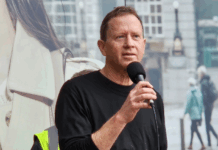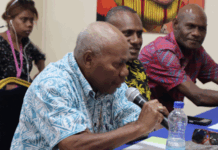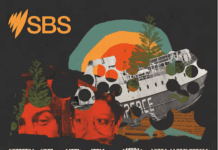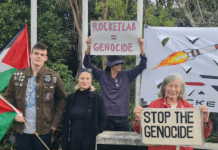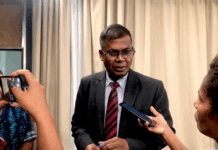A diverse group of scholars discuss “resetting” New Zealand’s Pacific-oriented foreign policy agenda. Video: Blessen Tom/NZ Institute of Pacific Research
By Sri Krishnamurthi
Debate has been lively and vigorous in response to the New Zealand government signalling a shift in foreign policy towards the Pacific Islands region.
To have a look closer at that debate the New Zealand Institute for Pacific Research (NZIPR) has brought together a diverse group of scholars from the University of Auckland who have research experience in the Pacific to discuss New Zealand’s Pacific-oriented foreign policy agenda, but more broadly to consider “where in the world is the Pacific?”
Associate Professor Yvonne Underhill-Sem (director of NZIPR and Development Studies, University of Auckland) chaired the discussion aptly titled “NZIPR Critical Conversation seminar”.
READ MORE: Browse RNZPR’s Lali blog
It was introduced by Professor Jenny Dixon (Deputy Vice-Chancellor, Strategic Engagement, University of Auckland) and featured Georgina Roberts (Ngāti Porou, Director of Pacific Connections at the Ministry of Foreign Affairs and Trade – MFAT), Associate Professor Damon Salesa (Pacific Studies at the Centre for Pacific Studies, University of Auckland), Dr Mark Busse (senior lecturer in Anthropology, University of Auckland), Dr Lisa Uperesa (senior lecturer in Pacific studies at the Centre for Pacific Studies, University of Auckland) and Associate Professor Chris Noonan (associate dean postgraduate international in the Faculty of Law, University of Auckland).
“The New Zealand government has invited everybody to think differently about how they do development in the Pacific and it came under this Pacific reset strategy. Winston Peters (Foreign Minister) took himself off to Australia to announce that this is what New Zealand is going to do,” Associate Professor Underhill-Sem said in her opening remarks.
“Since then there has been a lot of fabulous articles, discussion, blogs written about what does this all mean? What do we mean by a reset? And what are we resetting from – but more importantly what do we imagine the Pacific to be, how do we understand the Pacific?
“The question I’m asking [of the researchers] is what are the most meaningful boundaries that they undertake their research in, and hopefully we get an idea of how we can deal with some of the substantive development issues that really haven’t changed regardless of what the New Zealand government has done.
“We still have enduring development issues that need to be addressed.”
‘Shifting the dialogue’
Georgina Roberts of MFAT defined the Pacific reset as “shifting the dialogue” as the perspective of the Pacific changed.
“Statements were made at the beginning of March by the minister around needing to change the approach New Zealand takes with our region and moving from more of a donor-recipient relationship to one of partnership.
“It was about doing things differently, and that was to be underpinned by five key principles that was the basis of the reset, understanding, friendship, mutual benefit, collective ambition and sustainability.”
She said that meant the government had to interact, engage and collaborate with all the parties and stakeholders who had an interest in doing things better with their Pacific partners.
In the budget, the government had decided to allocate $714 million over the next four years in additional overseas assistance to mostly support the “Pacific reset”.
“Where will that money be spent? Climate change is a significant one, human development and this is an area of health and education for example, inclusive development and that means doing more to support youth and women in political representation and value issues, things like human rights, governance and democracy promotion – these are areas that haven’t gained as much attention in the previous years,” she said.
“There are a lot of challenges in our region.”
Working collectively
There were 30 government agencies that were involved in the Pacific and it was the government’s ambition to have them working collectively.
That led the discussion to the historical perspectives of the Pacific and what were the meaningful boundaries both geographically and temporally in the region, presented by Associate Professor Damon Salesa.
“New Zealanders don’t understand what New Zealand is. There are two New Zealands constitutionally – there is the New Zealand proper which is the New Zealand that most New Zealanders think of, that is North Island, South Island, Stewart Island and the Chatham Islands.
“But there is another constitutional entity called the realm of New Zealand which goes as far south as the Ross Territory and Antarctica and as far north as Tokelau, and includes the Cook Islands and Niue.
“So, part of that points out this other history of the New Zealand dollar, New Zealand language and New Zealand passport – those complexities remind us that even New Zealand is a contested, misunderstood concept for New Zealanders,” he said.
That meant there was a lot at stake with how New Zealanders defined the Pacific, and it was particularly important in terms of foreign policy.
It took in the definition of New Zealand’s Pacific, it was very specific in what the Pacific was.
“What New Zealand isn’t is, as seen by the Pacific people who live here.”
‘Two New Zealands’
“If we think about New Zealand as a nation the two most distinctive things about it, are Tangata Whenua (Māori ) and Tangata Pasifika (Pacific peoples). They are what make New Zealand not Australia or Canada. That is something very powerful about that way of being New Zealanders.
“For me the last frontier is finding a place for the Treaty (Treaty of Waitangi) in our foreign policy,” Associate Professor Salesa said.
Dr Mark Busse spoke about anthropological ways of defining the Pacific. He said there were two things that were important to consider – that even small communities, such as the one he lived in, in Papua New Guinea, were affected by international politics and international capitalism.
He said they had a profound impact on the lives of people living in those communities.
“I would suggest that the Pacific is less a geographical space or area, than a set of deep social and historical relationships, its people face large challenges, but I expect they will face those challenges by using values and knowledge that has been passed down over generations,” Dr Busse summed up.
What countries and territories, and their moving demographics and diaspora were considered around the Pacific to be in the Pacific, was Dr Lisa Uperesa’s discourse.
She said from the vantage point of the United States, ongoing migration of Pacific peoples, Micronesians, was shifting with people moving to Guam and Hawai’i.
Largest Pacific city
In the eyes of Americans, they would be surprised to hear that Auckland was the largest Pacific city in the world, the anthropologist and Pacific Studies senior lecturer said.
Her studies concentrated on Samoa and the fact that approximately 400,000 Samoans live abroad, primarily in the US, Australia and New Zealand, compared to 250,000 in American Samoa and independent Samoa.
“I focus on Samoan migration and mobility looking specifically at sport, and this has provided new boundaries of the definition of Pacific peoples and the way they move,” she said.
This project, she said, used sport to think about the history of migration and the place of sport in education and it also helped to reinforce the importance of place and importance of community history and agenda.
“The new Polynesian triangle includes cities like Auckland, Sydney, Honolulu, Los Angeles and Salt Lake City and in this vision the Pacific encompasses geographies and cartographies of presence, it is where Pacific people are,” she said.
Associate Professor Chris Noonan said that from a legal and trade perspective, the Pacific region didn’t exist.
“In the Pacific, the Pacific negotiations were supported by the Pacific Islands Forum Secretariat and funding from Europe through the Pacific Islands Forum Secretariat and negotiations took place because of institutional structures that were in place and not necessarily because the Pacific had a huge commonality,” said Associate Professor Noonan.
He outlined how and why the Pacific region negotiated both as a bloc and as individual countries.
Associate Professor Underhill-Sem said it was important that research in the Pacific was allowed to flourish and be given exposure through discussions like this “critical conversation”, which will be an on-going event on the NZIPR calendar.
Postgraduate AUT Pacific Media Centre students Sri Krishnamurthi and Blessen Tom (video) reported on the seminar in partnership with the NZ Institute for Pacific Research.


